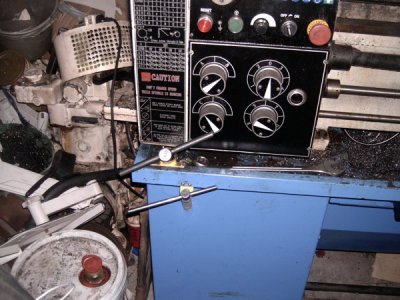-
Welcome back Guest! Did you know you can mentor other members here at H-M? If not, please check out our Relaunch of Hobby Machinist Mentoring Program!
You are using an out of date browser. It may not display this or other websites correctly.
You should upgrade or use an alternative browser.
You should upgrade or use an alternative browser.
Guys, I've figured something out!
- Thread starter Pcmaker
- Start date
- Joined
- Aug 29, 2013
- Messages
- 1,050
You've never misplaced a chuck key!
Nope, never. Actually I have a drawer just for lathe and drill chuck keys and I buy more of them whenever they come up for sale cheap. When I change chucks I return the old key to the drawer and take out the new one. I may have lost one or two along the way but I'll never confess to it. My drill press has the key tied to it by a string.
- Joined
- Feb 13, 2017
- Messages
- 2,138
Quoting:
I’m not saying abandon your idea, but will suggest developing a habit that will make it redundant while serving 2 important purposes. That is turning the chuck by hand every time after you set up a work piece in the chuck or alter its set up. First purpose is to verify that there is no interference between the chuck or the work piece and the lathe bed, carriage, cross slide, compound or whatever before you hit the go button. Second, if you leave the chuck key/wrench/t-shaped thingy/whatever you want to call it in the chuck, you will notice it immediately when you jam your hand into it when you reach in to turn the chuck.
A good practice there, for several practical reasons.... Way back when I was in EM (electrician, 1968) school, there was a practice in the mechanical school where machining was taught. If a student was seen leaving a key in the chuck, lathe, drill press, whatever, he had to wear a very large (and heavy) lathe chuck key on a lanyard for 24 hours. That cured most of the memory problems. Especially during meals....
In my case, having several chucks of varying types and sizes, the same quote from above applies. When the chuck near misses one time, it usually is enough. My machine is very old (older 'n me) and has few safeties beyond what I have put on it. The big issue is an odd shaped workpiece loaded. I always try it by hand first, by habit now.
The key is a good idea for locking out any/all machines, long term. But I would be skeptical of such a weight on the key. The switch wouldn't last long, even if the key did.
I’m not saying abandon your idea, but will suggest developing a habit that will make it redundant while serving 2 important purposes. That is turning the chuck by hand every time after you set up a work piece in the chuck or alter its set up. First purpose is to verify that there is no interference between the chuck or the work piece and the lathe bed, carriage, cross slide, compound or whatever before you hit the go button. Second, if you leave the chuck key/wrench/t-shaped thingy/whatever you want to call it in the chuck, you will notice it immediately when you jam your hand into it when you reach in to turn the chuck.
A good practice there, for several practical reasons.... Way back when I was in EM (electrician, 1968) school, there was a practice in the mechanical school where machining was taught. If a student was seen leaving a key in the chuck, lathe, drill press, whatever, he had to wear a very large (and heavy) lathe chuck key on a lanyard for 24 hours. That cured most of the memory problems. Especially during meals....
In my case, having several chucks of varying types and sizes, the same quote from above applies. When the chuck near misses one time, it usually is enough. My machine is very old (older 'n me) and has few safeties beyond what I have put on it. The big issue is an odd shaped workpiece loaded. I always try it by hand first, by habit now.
The key is a good idea for locking out any/all machines, long term. But I would be skeptical of such a weight on the key. The switch wouldn't last long, even if the key did.
Bill Hudson
- Joined
- Nov 15, 2016
- Messages
- 943
Having had my ears clipped hard if I ever had a key in the chuck without my hand on it I have a phobia about this subject! As has been mentioned good work habits are life savers. Make a holder/s and use them. I've developed a habit of putting the lathe in neutral and hitting the Emergency Stop switch whenever my hands go near the chuck, one it makes it easy to turn and two if I bumped the control rod nothing happens.
Good work habits and fear will keep you safe.

Good work habits and fear will keep you safe.

- Joined
- May 4, 2015
- Messages
- 3,583
Positively the key will break in the switch from the chuck key , weight or accidentally. Better off with a deadman switch like a limit switch to hang the chuck key on.
- Joined
- Jan 22, 2017
- Messages
- 104
Learn good work habits and its a non issue. I have a holder on my lathes for the chuck key and when ever I use it . Back in the holder it goes.
Been useing lathes for over 40 years and have never thrown a chuck key
Maybe so, but I remember Dad always taped the chuck key about 6 inches from the plug. You couldn't use the key when pluged in. Added feature - makes it hard to loose a chuck key!
